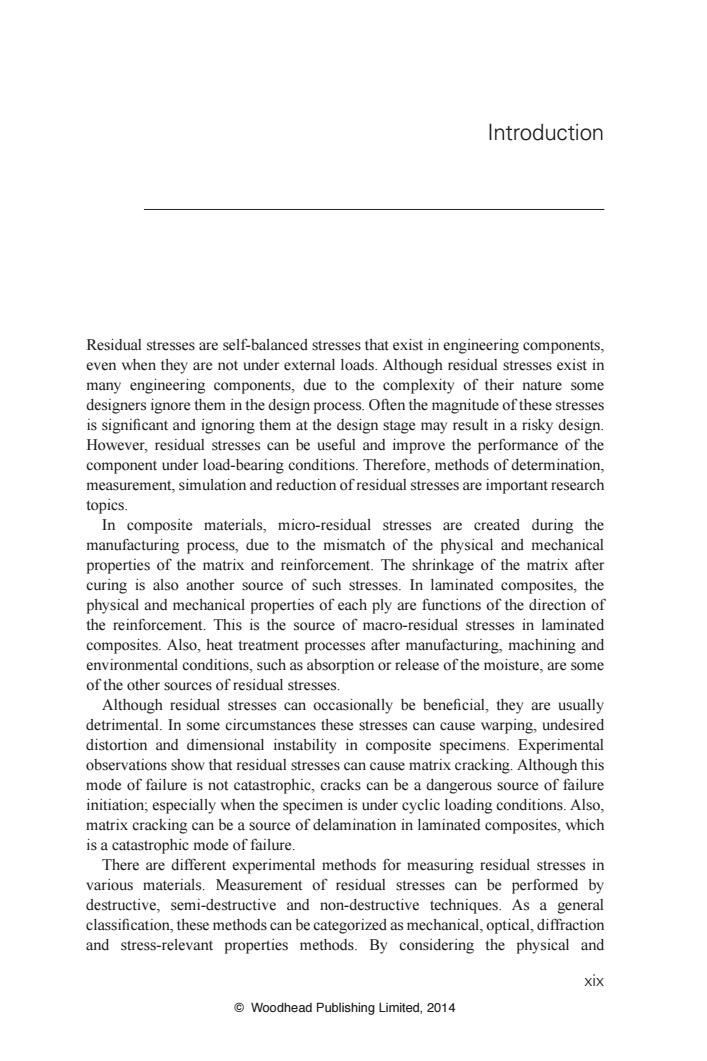正在加载图片...

Introduction Residual stresses are self-balanced stresses that exist in engineering components, even when they are not under external loads.Although residual stresses exist in many engineering components,due to the complexity of their nature some designers ignore them in the design process.Often the magnitude of these stresses is significant and ignoring them at the design stage may result in a risky design. However,residual stresses can be useful and improve the performance of the component under load-bearing conditions.Therefore,methods of determination, measurement,simulation and reduction of residual stresses are important research topics. In composite materials,micro-residual stresses are created during the manufacturing process,due to the mismatch of the physical and mechanical properties of the matrix and reinforcement.The shrinkage of the matrix after curing is also another source of such stresses.In laminated composites,the physical and mechanical properties of each ply are functions of the direction of the reinforcement.This is the source of macro-residual stresses in laminated composites.Also,heat treatment processes after manufacturing,machining and environmental conditions,such as absorption or release of the moisture,are some of the other sources of residual stresses. Although residual stresses can occasionally be beneficial,they are usually detrimental.In some circumstances these stresses can cause warping,undesired distortion and dimensional instability in composite specimens.Experimental observations show that residual stresses can cause matrix cracking.Although this mode of failure is not catastrophic,cracks can be a dangerous source of failure initiation;especially when the specimen is under cyclic loading conditions.Also, matrix cracking can be a source of delamination in laminated composites,which is a catastrophic mode of failure. There are different experimental methods for measuring residual stresses in various materials.Measurement of residual stresses can be performed by destructive,semi-destructive and non-destructive techniques.As a general classification,these methods can be categorized as mechanical,optical,diffraction and stress-relevant properties methods.By considering the physical and XIX Woodhead Publishing Limited,2014© Woodhead Publishing Limited, 2014 xix Residual stresses are self- balanced stresses that exist in engineering components, even when they are not under external loads. Although residual stresses exist in many engineering components, due to the complexity of their nature some designers ignore them in the design process. Often the magnitude of these stresses is signifi cant and ignoring them at the design stage may result in a risky design. However, residual stresses can be useful and improve the performance of the component under load- bearing conditions. Therefore, methods of determination, measurement, simulation and reduction of residual stresses are important research topics. In composite materials, micro- residual stresses are created during the manufacturing process, due to the mismatch of the physical and mechanical properties of the matrix and reinforcement. The shrinkage of the matrix after curing is also another source of such stresses. In laminated composites, the physical and mechanical properties of each ply are functions of the direction of the reinforcement. This is the source of macro- residual stresses in laminated composites. Also, heat treatment processes after manufacturing, machining and environmental conditions, such as absorption or release of the moisture, are some of the other sources of residual stresses. Although residual stresses can occasionally be benefi cial, they are usually detrimental. In some circumstances these stresses can cause warping, undesired distortion and dimensional instability in composite specimens. Experimental observations show that residual stresses can cause matrix cracking. Although this mode of failure is not catastrophic, cracks can be a dangerous source of failure initiation; especially when the specimen is under cyclic loading conditions. Also, matrix cracking can be a source of delamination in laminated composites, which is a catastrophic mode of failure. There are different experimental methods for measuring residual stresses in various materials. Measurement of residual stresses can be performed by destructive, semi- destructive and non- destructive techniques. As a general classifi cation, these methods can be categorized as mechanical, optical, diffraction and stress- relevant properties methods. By considering the physical and Introduction